
Catching up with…Suicide Research
There’s an urgent need for mental health researchers and practitioners to stay up to date with research on suicidology. Practitioners, though, often struggle to find time to really dig into recent findings. Inspired by some of our recent work tracking health equity, along with the welcome news that suicides seemingly declined during early days of the pandemic, I decided to analyze the past 101 days of research into suicide.
To do this, I pulled all the abstracts of all articles published by four journals:

I also searched for any articles containing the phrase “suicid*”, which covers derivatives of the word “suicide.” The process yielded 475 unique articles across 185 journals.
To get a broad picture, I first generated a word cloud. For the unfamiliar, in a word cloud, the size of the word indicates its relative frequency compared to other words. Bigger words showed up more often in the research. The colors in the graph are merely a stylistic flourish, they don’t indicate anything here.
What really jumped out to me is what wasn’t in there. For the past few months of tracking research trends, COVID-19 has been dominating the paradigms. I was surprised not to see it in this group of major topics.

I then took a look at the top 50 phrases that occurred frequently and plotted these as a network. In this figure, the size of the circle means a more frequently occurring word, and the thickness of the line corresponds to a more frequently occurring relationship.
Implicit COVID research shows up here. We can see that the research explored social distancing. Two really interesting phrases were “perceived burdensomeness” and “thwart belongingness.” Two special populations were also identified: college students and sexual minorities.
I then looked at how these 500-ish articles clustered together. First, I used an LDA clustering algorithm and then assigned each abstract to its most likely cluster. I then extracted the six sentences that were more representative of the topics. With this data set, I used the term-frequency, inverse document frequency method to determine what three words were most distinguishing for each topic. I went through those methods really fast, so if you want the slower version, check out this article that my colleague Victoria Scott and I just published in Implementation Science.
The figure below shows the topic and the number of articles on those topics. The topics can be found as the word strings on the y-axis (the preceding number was the assigned topic number). The most frequently occurring topics including things like Veterans, COVID-19, severity, and this long string that included belongingness and burdensomeness. So COVID is, in fact, a topic of interest after all. This goes to show that we can’t just rely on simple word count when it comes to determining research trends.

There was one more step. I went through and identified the article that was most representative of each topic. This can be found below and can be downloaded as a pdf. table. Here’s a quick picture excerpt.

I’m also into review articles (who isn’t?!), so I pulled all the articles to purported to do some synthesis over the past 101 days. There were twenty-five of them.
If you are in crisis or you think you may have an emergency, call your doctor or 911 immediately. If you’re having suicidal thoughts, call 1-800-273-TALK (8255) to talk to a skilled, trained counselor at a crisis center in your area at any time (National Suicide Prevention Lifeline). If you are located outside the United States, call your local emergency line immediately.



